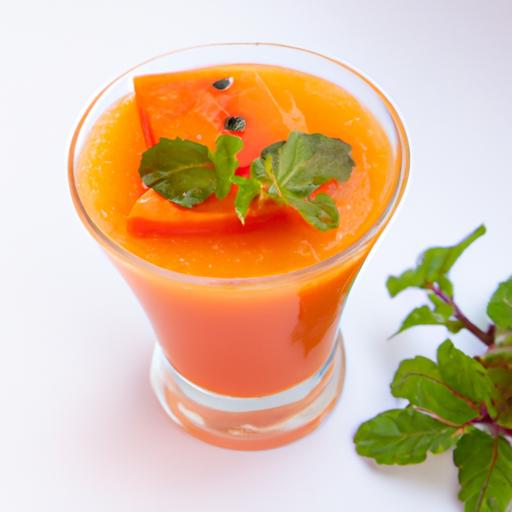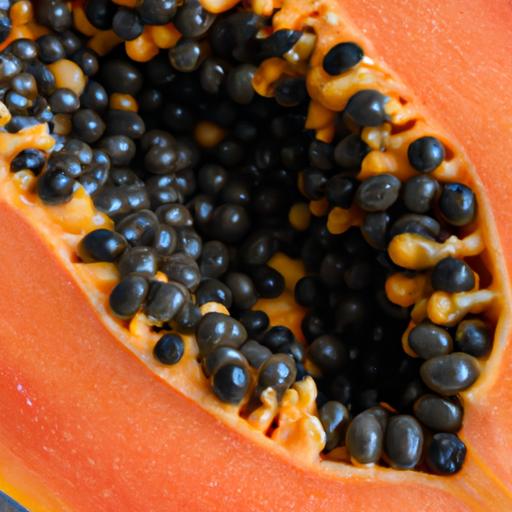Can You Eat Papaya Skin? Exploring the Nutritional Benefits and Culinary Uses
Papaya, a tropical fruit known for its vibrant color and sweet taste, has gained popularity for its numerous health benefits. From aiding digestion to boosting immune function, papaya is a nutritional powerhouse. But here’s a question that may have crossed your mind: can you eat papaya skin? In this article, we will delve into the topic, uncovering the truth behind consuming papaya skin and exploring its potential culinary uses.
A Brief Explanation of Papaya and Its Benefits
Before we dive into the topic at hand, let’s take a moment to appreciate the wonders of papaya. This tropical fruit, also known as Carica papaya, is native to Central America and is now cultivated in various parts of the world. Papaya is rich in essential vitamins and minerals, including vitamin C, vitamin A, folate, potassium, and magnesium. Its high fiber content makes it an excellent choice for promoting digestive health and maintaining a healthy weight.
Introducing the Topic of Eating Papaya Skin
Now, let’s address the intriguing question: can you eat papaya skin? Surprisingly, the answer is yes! While many people discard the skin and only consume the juicy flesh, papaya skin is not only edible but also packed with nutritional benefits. The skin contains a substantial amount of fiber, antioxidants, and enzymes that can contribute to overall well-being.
However, it is important to note that not all papaya skins are suitable for consumption. If you decide to eat papaya skin, it is crucial to choose organic, pesticide-free papayas. Additionally, it is advisable to wash the skin thoroughly before consuming to remove any potential contaminants.
In the following sections, we will explore the nutritional value of papaya skin, discuss its safety and edibility, and provide you with creative ways to prepare and incorporate it into your meals. So, let’s embark on this papaya skin culinary adventure together and unlock the hidden potential of this often overlooked part of the fruit.
Nutritional Value of Papaya Skin
A. Nutrients Present in Papaya Skin
When it comes to the nutritional value of papaya skin, you’ll be pleasantly surprised. The skin of the papaya fruit contains a wide array of beneficial nutrients that can contribute to your overall health and well-being. It is rich in fiber, antioxidants, vitamins, and minerals that can support various bodily functions.
The fiber content in papaya skin aids in digestion and promotes a healthy digestive system. It helps regulate bowel movements, prevents constipation, and supports the growth of beneficial gut bacteria. Additionally, the skin of papaya contains significant amounts of vitamin C, vitamin A, and potassium, which are essential for immune function, healthy vision, and maintaining electrolyte balance in the body.
B. Potential Health Benefits of Papaya Skin
Consuming papaya skin can offer a range of potential health benefits. The high fiber content in the skin aids in weight management by providing a feeling of fullness and reducing calorie intake. It can also help lower cholesterol levels and maintain healthy blood sugar levels.
The antioxidants present in papaya skin, such as flavonoids and carotenoids, help combat oxidative stress and reduce the risk of chronic diseases, including heart disease and certain types of cancer. These antioxidants also contribute to healthy skin by protecting it from free radicals and promoting a youthful complexion.
Furthermore, papaya skin contains enzymes such as papain and chymopapain, which have anti-inflammatory properties and can aid in reducing inflammation in the body. This can be particularly beneficial for individuals with inflammatory conditions such as arthritis.
Incorporating papaya skin into your diet can thus provide you with a host of nutrients and potential health benefits. In the next section, we will address the safety and edibility of papaya skin, ensuring you have all the necessary information to make an informed decision about incorporating it into your meals.
Safety and Edibility of Papaya Skin
Addressing Concerns about the Safety of Consuming Papaya Skin
When it comes to consuming papaya skin, it’s natural to have concerns about safety. After all, we are accustomed to enjoying the juicy flesh of the fruit while discarding the outer skin. However, research suggests that papaya skin can be safely consumed, provided certain precautions are taken.
One common concern is the presence of pesticides on the skin. To mitigate this, it is crucial to choose organic papayas or thoroughly wash conventionally grown papayas to remove any pesticide residues. By doing so, you can minimize potential health risks and ensure a safer eating experience.
Discussing the Potential Risks and Precautions to Consider
While papaya skin is generally safe for consumption, it’s important to be aware of a few potential risks and take necessary precautions:
-
Allergies: Some individuals may have allergic reactions to papaya skin. If you have a known allergy to latex or have experienced allergic reactions to other fruits, it is advisable to exercise caution or consult with a healthcare professional before consuming papaya skin.
-
Digestive Sensitivity: The high fiber content of papaya skin may cause digestive discomfort in some individuals. If you have a sensitive digestive system or a history of digestive issues, it’s recommended to start with small amounts and gradually increase your intake to assess tolerance.
-
Contaminants: As with any fruit or vegetable, there is a risk of contamination from bacteria or other pathogens. Thoroughly washing the papaya skin before consumption can reduce this risk.
By being mindful of these potential risks and taking appropriate precautions, you can safely include papaya skin in your diet and reap its nutritional benefits. In the next section, we will explore the various ways to prepare and enjoy papaya skin, opening up a world of culinary possibilities.
Culinary Uses of Papaya Skin
Exploring Different Cuisines that Incorporate Papaya Skin
Papaya skin, often overlooked, can be a delightful addition to various cuisines around the world. Let’s take a journey through some culinary traditions that embrace the use of papaya skin:
1. Thai Cuisine
In Thai cuisine, green papaya salad, also known as “Som Tam,” is a popular dish that features shredded unripe papaya mixed with a tangy and spicy dressing. The inclusion of papaya skin adds a unique texture and a slightly bitter taste that balances the flavors of this refreshing salad.
2. Caribbean Cuisine
In Caribbean cuisine, papaya skin is often used in chutneys and relishes. These condiments add a vibrant and zesty element to dishes like jerk chicken or roasted pork. The papaya skin’s slightly tart flavor and crunchy texture provide a delightful contrast to the rich and savory flavors of the main dishes.
3. Latin American Cuisine
Latin American cuisines, particularly in Mexico and Brazil, embrace the use of papaya skin in traditional recipes. In Mexico, candied papaya skin is a popular sweet treat, where the skin is cooked with sugar syrup until tender and then enjoyed as a dessert or used to garnish pastries. In Brazil, papaya skin is used to make “doce de mamão verde,” a sweet preserve that is often enjoyed with cheese or spread on toast.
Discussing the Flavors and Textures It Adds to Dishes
Papaya skin offers more than just its nutritional benefits; it also contributes unique flavors and textures to dishes. When prepared and cooked properly, papaya skin can enhance the overall taste experience. Here are some ways papaya skin can elevate your culinary creations:
1. Texture
Papaya skin, when cooked, becomes tender with a slightly chewy texture. This adds a delightful contrast to dishes that would otherwise lack textural variety. Whether sautéed, pickled, or added to stir-fries, the papaya skin brings a satisfying bite to each mouthful.
2. Bitterness
The papaya skin carries a hint of bitterness, which can provide a pleasant complexity to dishes. When balanced with other flavors, such as sweetness or acidity, the bitterness of the skin can create a harmonious taste profile that tantalizes the palate.
3. Subtle Flavor
While the flavor of papaya skin is milder compared to the flesh, it still holds a subtle fruity essence. When used in cooking, it imparts a delicate papaya flavor that complements a wide range of ingredients, enhancing the overall taste of the dish.
By exploring different cuisines and experimenting with various cooking methods, you can unlock the full potential of papaya skin and introduce a new dimension to your culinary repertoire. So, don’t shy away from incorporating this often overlooked part of the fruit into your dishes and embrace the unique flavors and textures it brings to the table.
Conclusion
In conclusion, the question “Can you eat papaya skin?” has been answered with a resounding yes. Papaya skin, often discarded as waste, can actually be a valuable addition to your diet. Not only does it contain a host of beneficial nutrients, but it also adds a unique flavor and texture to your culinary creations.
Throughout this article, we have explored the nutritional value of papaya skin, discussed its safety and edibility, and provided various methods to prepare and enjoy it. From stir-fries to smoothies, there are countless ways to incorporate papaya skin into your meals and elevate your dining experience.
However, it is important to exercise caution and ensure that you are consuming organic, pesticide-free papayas. Additionally, if you have any allergies or sensitivities, it is best to consult with a healthcare professional before incorporating papaya skin into your diet.
So, the next time you indulge in a juicy papaya, don’t be so quick to discard the skin. Embrace the culinary possibilities and reap the nutritional benefits of this often overlooked part of the fruit. Give it a try and discover a whole new world of flavors and textures that will tantalize your taste buds and nourish your body.
Remember, with papaya skin, you’re not just reducing waste, but you’re also embracing a more sustainable approach to food consumption. So why not embark on this papaya skin adventure and make the most of this versatile and nutritious fruit? Happy eating!


